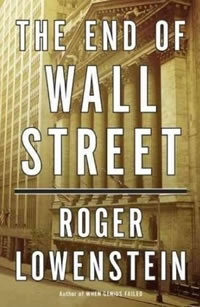Book Notes
 Roger Lowenstein, The End of Wall Street (New York: Penguin Press, 2010), 339pp.
Roger Lowenstein, The End of Wall Street (New York: Penguin Press, 2010), 339pp.
When Wall Street imploded in the fall of 2008, my father-in-law's stock in Lehman Brothers plummeted from $16,000 to $12 in one month. Lehman's bankruptcy on September 15, 2008 was the largest in US history. The demise of the 164-year-old firm sent shock waves throughout global markets, and in the successive weeks it became apparent that it was only the tip of a large iceberg. AIG faced $80 billion of exposure. Bear Stearn's stock traded at 62 that fall and ended up at 2 by the end of one fateful week. Lowenstein's book explains how and why all this happened.
There's plenty of blame to go around. Many firms had reached incomprehensible levels of leverage. Lehman, for example, was leveraged 26:1, meaning they had one dollar in the bank for every $26 that they had borrowed. Bear Stearns was at 29, and Morgan Stanley at 32. Fannie Mae's leverage stood at 110:1, and Freddie Mac's was at an eye-popping 170:1. "They were pursuing a strategy," writes Lowenstein, "(endorsed by the SEC) of using a dollar of their own money and roughly twenty-nine dollars of other peoples' and wagering it on a truly manic market" (76, 116, 123).
The ratings agencies Moody's and S&P blessed their arcane financial instruments with high ratings, and faced an inherent conflict of interest since they were paid by the firms they rated. There was active hostility against regulating questionable practices. Alan Greenspan, Ben Bernanke, and Henry Paulson assured people that there were no undue risks. Fannie Mae and Freddie Mac were forced to either lower their credit standards or lose market share to competitors. The subprime lenders made loans to people with little or no documentation of income or employment, and that were designed to fail, so that customers could be signed up for new and even riskier loans. Executive compensation was shameless. When AIG's board fired its CEO Martin Sullivan, he received a $47 million package, "equal to what the average American would earn in a thousand years. And Sullivan had failed." (141).
"What truly failed," though, Lowenstein concludes at the end of his book, "was the post-industrial model of capitalism" (287), that is, a model of absolute and implicit trust in unregulated free markets. But "never had the power of finance to inflict damage on the society it serves been so painfully clear" (284). My father-in-law would agree.


